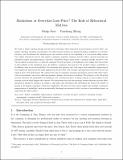Markdown or Everyday Low Price? The Role of Behavioral Motives
Author(s)
Özer, Özalp; Zheng, Yanchong
DownloadMarkdown or everyday-low-price.pdf (871.3Kb)
OPEN_ACCESS_POLICY
Open Access Policy
Creative Commons Attribution-Noncommercial-Share Alike
Terms of use
Metadata
Show full item recordAbstract
We study a seller’s optimal pricing and inventory strategies when behavioral (nonpecuniary) motives affect consumers’ purchase decisions. In particular, the seller chooses between two pricing strategies, markdown or everyday low price, and determines the optimal prices and inventory level. Two salient behavioral motives that impact consumers’ purchase decisions and the seller’s optimal strategies are anticipated regret and misperception of product availability. Regret arises when a consumer initially chooses to wait but encounters stockout later, or when the consumer buys the product at the high price but realizes that the product is still available at the markdown price. In addition, consumers often perceive the product’s future availability to be different than its actual availability. We determine and quantify that both regret and availability misperception have significant operational and profit implications for the seller. For example, ignoring these behavioral factors can result in up to 10% profit losses. We contrast the roles of consumers’ strategic (pecuniary) motives with their behavioral (nonpecuniary) motives in affecting purchase, pricing, and inventory decisions. The presence of the behavioral motives reinstates the profitability of markdown over everyday low price, in sharp contrast to prior studies of only strategic motives that suggest the contrary. We characterize how and why strategic versus behavioral motives affect decisions in distinctive manners. In doing so, this paper also introduces and determines the behavioral benefits of pricing in leveraging consumers’ behavioral regularities. We advocate that tactics that may intensify consumers’ misperception of availability, such as disclosing low inventory levels, can have a far-reaching impact on improving the seller’s profit.
Date issued
2015-11Department
Sloan School of ManagementJournal
Management Science
Publisher
Institute for Operations Research and the Management Sciences (INFORMS)
Citation
Özer, Özalp and Zheng, Yanchong. “Markdown or Everyday Low Price? The Role of Behavioral Motives.” Management Science 62, no. 2 (February 2016): 326–346
Version: Author's final manuscript
ISSN
0025-1909
1526-5501